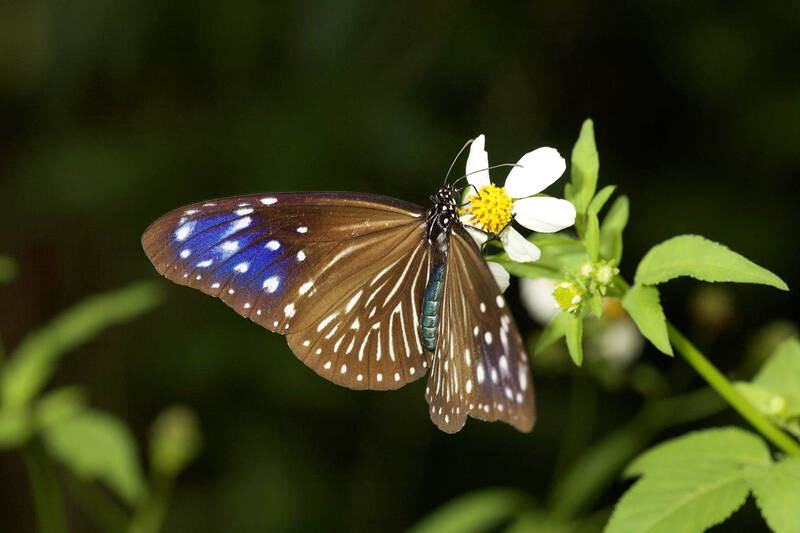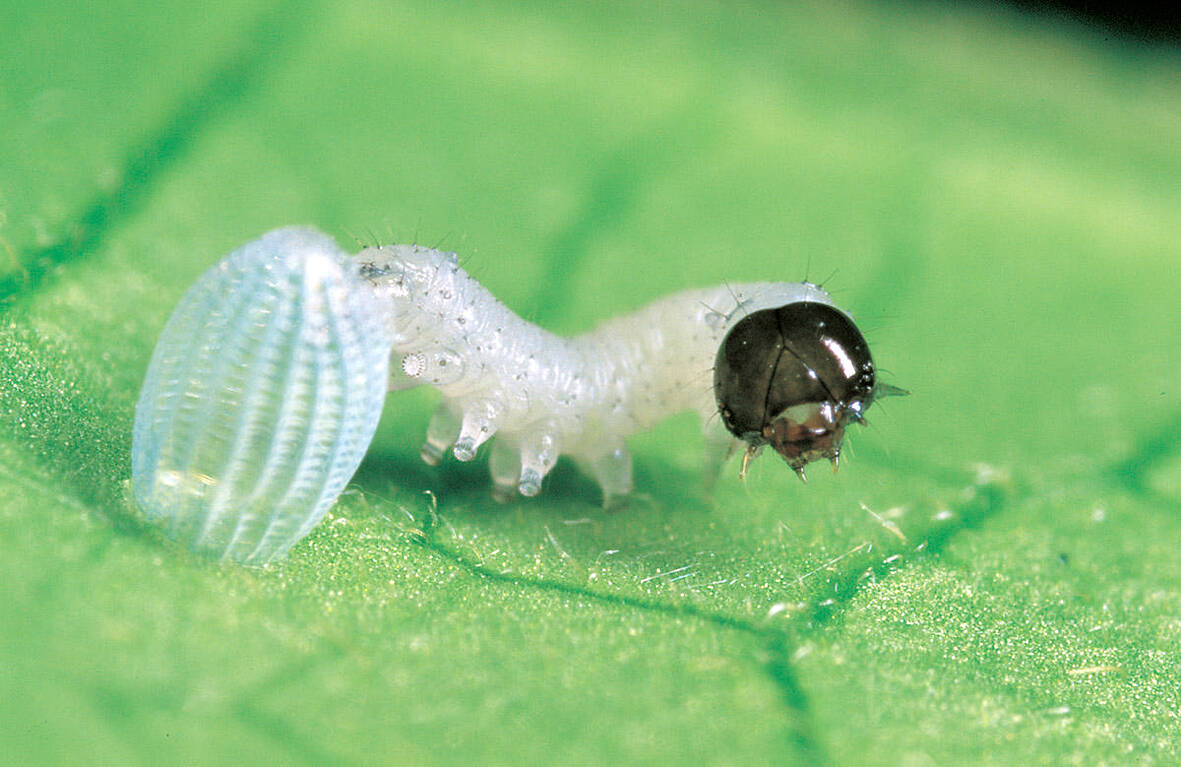Guided by the subdued, soothing and sometimes playful voice of singer Anpu (安浦), this stunning documentary uses ultra high speed (4k, 1,000fps) cameras to give the audience an extremely intimate view of the anatomy, life cycle and plight of the purple crow butterfly.
Once dubbed the Butterfly Kingdom, Taiwan boasts four subspecies of the creature named for the dazzling purple sheen its wings give off in the sunlight. There used to be five subspecies, but one has not been seen since the 1960s. Their 400km-long winter migration is one of the two largest in the world, the other being the flight of the monarchs from the US to Mexico.
Born in the north, the purple crow butterflies flock to valleys in the south in the tens of thousands when the weather gets cold, making for a spectacular sight called the “butterfly highway.” But their numbers have been sharply decreasing due to climate change, habitat destruction and the building of highways that block their travel routes.

Photo courtesy of Activator Marketing Corp
They’re not endangered yet, but dozens of “butterfly valleys” have disappeared in recent years, indicating an imbalance in the natural ecology. What will happen if they completely disappear one day?
Conservationist Chan Chia-lung (詹家龍) spent five years shooting absolutely gorgeous, close-up scenes of the butterflies that often show the minute details of its tiny wings filling up the entire theater screen. It’s a sumptuous feast for the eyes, as we not only rarely get to observe the life processes of these butterflies (who knew they had metallic, reflective chrysalises?), but their movements are often too rapid to observe with the naked eye — or even regular video cameras.
The sound of their wings beating is also presented, and since that’s the only noise they make, the cheery, whimsical original soundtrack by the renowned Tu Duu-chih (杜篤之) helps drive the story forward and set the pace.

Photo courtesy of Activator Marketing Corp
Chan also shows in detail the many gruesome ways they may meet their end, from being eaten from the inside out by parasitic wasp larvae, to collapsing out of exhaustion and being devoured by other insects. In one scene, the butterflies are shown struggling to cross a highway, many meeting their fate on the tires of a truck. When butterflies were way more abundant, families bolstered their income by hunting them, turning them into specimens and even using their wings to create “butterfly paintings” that were sold abroad.
Anpu speaks directly to her subject in the second person — from the moment it eats its way out of the egg to the trials and tribulations it will encounter. It’s a curious device that works just fine, but at times gets a little too cutesy as though the butterflies (and the audience) are children.
The narration anthropomorphizes the butterflies as the charming, magical heroes of this tale, using human emotions, sensory experiences and complex concepts to describe their behaviors. But some of the commentary is a bit far-fetched, assigning the purple crow butterflies attributes and thinking that elevates them above other insect species.

Photo courtesy of Activator Marketing Corp
Anyhow, this treatment does make the butterflies more relatable and appealing to a wider audience, and also makes it more fun to watch than a serious nature doc. The goal seems to be to make people care about them and strive to protect them. The parts dealing with death are handled quite well, the music doesn’t suddenly get sad and it’s by no means painted as a tragedy. Don’t be upset, Anpu says, this is just part of the cycle of life. Your body will serve to nourish other insects before it returns to dust.
The film makes use of quite a bit of aerial footage from the Chi Po-lin Foundation (齊柏林) to show the butterflies’ habitat and migration journey. There’s one strange error on the part showing the journey south, when a scene of Taipei suddenly appears after they have reached Kaohsiung.
It’s wonderful to be able to see the minute processes of the butterfly’s life cycle, but that takes up the bulk of the 82-minute running time. Chan doesn’t want to get too preachy, preferring to let the story speak for itself. But the film could have expounded a bit more on the human impact on these delightful creatures and the implications of their population decrease, and how they can be protected.
There’s also a segment describing the butterfly-related legends of ancient China and Greece, but what about their relationship to the indigenous Rukai and Paiwan people, in whose traditional territories they spend the winter?
Sponsored by Yushan Bank (玉山銀行), this crowdfunded film premieres just three months after the hynobius salamander documentary Good Morni MIT (山椒魚來了), which also introduces through a celebrity narrator (Wubai, 伍佰) the life of a tiny, often overlooked creature that’s also seeing its habitat disappear. Hopefully this becomes a trend, as there’s so much of Taiwan’s rich biodiversity that most urban folk are unaware of. One might question the need to go to a theater to watch a nature documentary, but seeing these amazing shots on the big screen is worth the while.

A vaccine to fight dementia? It turns out there may already be one — shots that prevent painful shingles also appear to protect aging brains. A new study found shingles vaccination cut older adults’ risk of developing dementia over the next seven years by 20 percent. The research, published Wednesday in the journal Nature, is part of growing understanding about how many factors influence brain health as we age — and what we can do about it. “It’s a very robust finding,” said lead researcher Pascal Geldsetzer of Stanford University. And “women seem to benefit more,” important as they’re at higher risk of

Last week the Democratic Progressive Party (DPP) said that the budget cuts voted for by the China-aligned parties in the legislature, are intended to force the DPP to hike electricity rates. The public would then blame it for the rate hike. It’s fairly clear that the first part of that is correct. Slashing the budget of state-run Taiwan Power Co (Taipower, 台電) is a move intended to cause discontent with the DPP when electricity rates go up. Taipower’s debt, NT$422.9 billion (US$12.78 billion), is one of the numerous permanent crises created by the nation’s construction-industrial state and the developmentalist mentality it

Experts say that the devastating earthquake in Myanmar on Friday was likely the strongest to hit the country in decades, with disaster modeling suggesting thousands could be dead. Automatic assessments from the US Geological Survey (USGS) said the shallow 7.7-magnitude quake northwest of the central Myanmar city of Sagaing triggered a red alert for shaking-related fatalities and economic losses. “High casualties and extensive damage are probable and the disaster is likely widespread,” it said, locating the epicentre near the central Myanmar city of Mandalay, home to more than a million people. Myanmar’s ruling junta said on Saturday morning that the number killed had

Mother Nature gives and Mother Nature takes away. When it comes to scenic beauty, Hualien was dealt a winning hand. But one year ago today, a 7.2-magnitude earthquake wrecked the county’s number-one tourist attraction, Taroko Gorge in Taroko National Park. Then, in the second half of last year, two typhoons inflicted further damage and disruption. Not surprisingly, for Hualien’s tourist-focused businesses, the twelve months since the earthquake have been more than dismal. Among those who experienced a precipitous drop in customer count are Sofia Chiu (邱心怡) and Monica Lin (林宸伶), co-founders of Karenko Kitchen, which they describe as a space where they